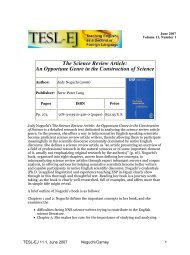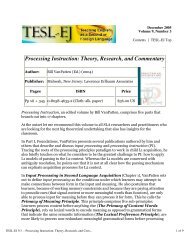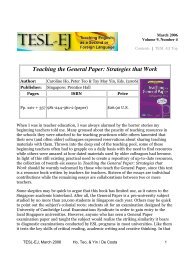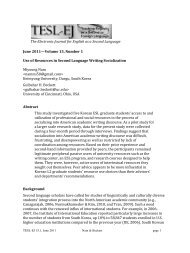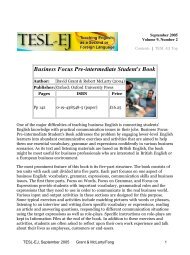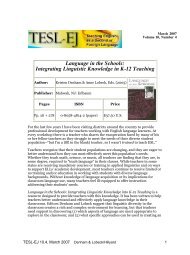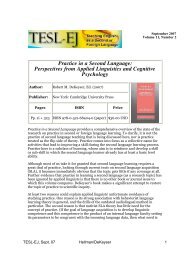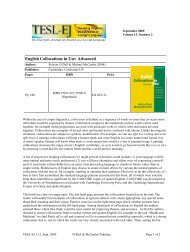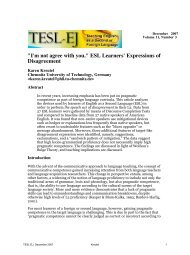The Electronic Journal for English as a Second Language - TESL-EJ
The Electronic Journal for English as a Second Language - TESL-EJ
The Electronic Journal for English as a Second Language - TESL-EJ
You also want an ePaper? Increase the reach of your titles
YUMPU automatically turns print PDFs into web optimized ePapers that Google loves.
<strong>The</strong> <strong>Electronic</strong> <strong>Journal</strong> <strong>for</strong> <strong>English</strong> <strong>as</strong> a <strong>Second</strong> <strong>Language</strong><br />
December 2009 — Volume 13, Number 3<br />
<strong>Second</strong> <strong>Language</strong> Incidental Vocabulary Learning: <strong>The</strong> Effect of Online Textual,<br />
Pictorial, and Textual Pictorial Glosses<br />
Seyyed Abdollah Shahrokni<br />
Iran University of Science and Technology (IUST)<br />
sa_shahrokni@lang.iust.ac.ir;<br />
sa_shahrokni@yahoo.com<br />
Abstract<br />
This empirical study investigates the effect of online textual, pictorial, and textual pictorial<br />
glosses on the incidental vocabulary learning of 90 adult elementary Iranian EFL learners.<br />
<strong>The</strong> participants were selected from a pool of 140 volunteers b<strong>as</strong>ed on their per<strong>for</strong>mance on<br />
an <strong>English</strong> placement test <strong>as</strong> well <strong>as</strong> a knowledge test of the target words in the study.<br />
Afterward, they were randomly <strong>as</strong>signed to 3 groups of 30 and subsequently exposed to the<br />
research treatment. During 3 sessions of instruction, 5 computerized reading texts including<br />
25 target words were studied. <strong>The</strong> participants read the texts <strong>for</strong> comprehension and, at the<br />
same time, were able to consult the glosses attached to the target words. Having read each<br />
text under each research condition, the participants were tested on their incidental<br />
vocabulary learning through two research instruments, word and picture recognition tests.<br />
<strong>The</strong> results of a one-way ANOVA analysis of the data indicate that a combination of text and<br />
still images resulted in significantly better incidental vocabulary learning, confirming the<br />
Dual-coding <strong>The</strong>ory (Paivio, 1971, 1990).<br />
Introduction<br />
Research suggests that a large portion of the vocabulary children learn in their L1 is<br />
incidental in nature, a by-product of reading (Huckin & Coady, 1999) or listening (Nagy,<br />
Anderson & Herman, 1987) which provides at le<strong>as</strong>t three benefits <strong>for</strong> language learners:<br />
1. a richer gr<strong>as</strong>p of the contextual meaning and use<br />
2. the concurrency of the two activities (e.g., reading/listening and vocabulary learning)<br />
3. a more learner-centered learning process.<br />
<strong>TESL</strong>-<strong>EJ</strong> 13.3, December 2009 Shahrokni 1 of 17
Likewise, it is generally accepted that a considerable percentage of learners’ L2 vocabulary is<br />
acquired incidentally. Huckin and Coady (1999) highlight the importance of incidental<br />
vocabulary learning by referring to several studies indicating that learners gain more<br />
vocabulary knowledge through extensive reading with guessing at the meaning of unknown<br />
words.<br />
However, despite the obvious advantages, there are also a number of disadvantages <strong>for</strong><br />
incidental vocabulary learning. For example, research suggests that contextual in<strong>for</strong>mation is<br />
often unclear <strong>for</strong> language learners to make correct inferences (Bensoussan & Laufer, 1984;<br />
Mondria & Wit-de Boer, 1991), leading to learners’ making wrong inferences and, thus,<br />
running the risk of learning words incorrectly. Interestingly; however, one of the ways such a<br />
disadvantage might be alleviated is by using marginal glosses (Hulstijn, Hollander &<br />
Greidanus, 1996), which h<strong>as</strong> proved quite effective in printed materials.<br />
Despite the mixed views (James, 1996) towards the potentials of Computer Assisted<br />
<strong>Language</strong> Learning (CALL), one can consider the element of time being highly influential in<br />
judging technology related issues. According to Jones (2000), the availability of many<br />
current electronic resources provides numerous opportunities <strong>for</strong> making texts more<br />
comprehensible to learners. Indeed, one of the recent developments in making texts more<br />
comprehensible to readers is using computerized glosses/annotations.<br />
Glosses<br />
According to Lomicka (1998), the concept of glossing “dates back to the Middle Ages when<br />
students struggling with a <strong>for</strong>eign text, usually Latin, produced them <strong>as</strong> they moved along<br />
during the reading process” (p. 41). <strong>The</strong>y are “typically located in the side or bottom margins<br />
of a page, [and] are most often supplied <strong>for</strong> unfamiliar words, which may help to limit<br />
continual dictionary consultation that may hinder and interrupt the L2 reading<br />
comprehension process” (p. 42). However, this learner-oriented technique w<strong>as</strong> soon adopted<br />
by teachers and pedagogues so that they could present a short definition or note <strong>for</strong> unknown<br />
words to facilitate the reading comprehension process <strong>for</strong> L2 learners. <strong>The</strong> issue of glossing<br />
is by no means a medieval phenomenon now. Leloup and Ponterio (2000) refer to the current<br />
status of glossing <strong>as</strong>: “[T]he cues that appear when the reader clicks on the glossed<br />
vocabulary take various <strong>for</strong>ms. Some are text explanations only, generally using a<br />
combination of target language and <strong>English</strong> words. Others are pictorial representations of the<br />
meaning of the word or phr<strong>as</strong>e” (p. 7).<br />
Roby’s (1998) taxonomy of the present types and significance of glosses in teaching, serves<br />
to almost comprehensively depict the different layers of such contemporary teaching aids. In<br />
fact, nowadays researchers consider the usefulness of glosses <strong>as</strong> a point of departure, and it is<br />
investigating the different types that constitute much of the current research (Yoshii, 2006).<br />
<strong>The</strong>re<strong>for</strong>e, the following presents a brief review of the related literature on the effectiveness<br />
of non-CALL and CALL glosses <strong>as</strong> used in vocabulary acquisition research.<br />
<strong>TESL</strong>-<strong>EJ</strong> 13.3, December 2009 Shahrokni 2 of 17
Non-CALL Glosses<br />
Concerning the possible usefulness of glosses in <strong>as</strong>suaging the disadvantages of incidental<br />
vocabulary learning, several studies have investigated glossed printed materials. Working<br />
with American students studying Spanish <strong>as</strong> an L2, Jacobs, Dufon, and Fong (1994) found<br />
that the per<strong>for</strong>mance of the gloss condition w<strong>as</strong> significantly better on a vocabulary test<br />
administered immediately after the treatment. This study also compared the effectiveness of<br />
L1 and L2 glosses which found no significant difference between the two.<br />
Further supporting evidence comes from Hulstijn, et al. (1996) who conducted their research<br />
with Dutch students learning French <strong>as</strong> an L2. This study showed that having access to L1<br />
marginal glosses w<strong>as</strong> more effective than using bilingual dictionaries or, similarly, having no<br />
access to dictionaries or marginal glosses.<br />
Watanabe (1997) investigated how text modification and t<strong>as</strong>k would affect incidental<br />
vocabulary learning. This study, which w<strong>as</strong> carried out with Japanese university students,<br />
indicated that the use of L2 glosses in the texts helped the participants retain more<br />
vocabulary compared to when they worked with texts containing no modifications, or<br />
appositives. This study also established no significant difference in the effectiveness of L1<br />
and L2 glosses. Furthermore, the research compared single- and multiple-choice glosses. <strong>The</strong><br />
participants were required to choose the correct definition from the two alternatives offered,<br />
which revealed no significant difference in the effectiveness of the two types. However, this<br />
finding might be slightly different from what Nagata (1999) revealed b<strong>as</strong>ed on a Japanese<br />
courseware program called Banzai Readings (ple<strong>as</strong>e see the section on CALL glosses).<br />
Working with American students learning German <strong>as</strong> an L2 in a second semester course,<br />
Kost, Foss, and Lenzini (1999) compared three types of L1 glosses, Text-only, Picture-only,<br />
and Text-and-Picture. <strong>The</strong> results indicated that the Text-and-Picture (combination) condition<br />
w<strong>as</strong> the most effective of the three types. A similar study by Yoshii and Flaitz (2002), by<br />
comparison, examined the learners’ incidental vocabulary learning through incorporating the<br />
t<strong>as</strong>k into an online computerized environment (ple<strong>as</strong>e see below).<br />
CALL Glosses<br />
Chun and Pl<strong>as</strong>s (1996) investigated the effect of multimedia annotations on the incidental<br />
vocabulary learning of 160 university German students. Using their computerized reading<br />
program, they conducted three studies, employing a within subjects design. <strong>The</strong> students<br />
used the same version of the program and worked with the program in a realistic L2 learning<br />
situation. Afterward, the participants were tested on their incidental vocabulary learning and<br />
overall reading comprehension while being free to choose the available annotations. <strong>The</strong><br />
results indicated that “the recall protocol <strong>for</strong> visual annotations (that is, words annotated with<br />
<strong>TESL</strong>-<strong>EJ</strong> 13.3, December 2009 Shahrokni 3 of 17
text and pictures, text and video) w<strong>as</strong> higher than <strong>for</strong> words annotated with text alone” (p.<br />
189).<br />
Lyman-Hager and Davis (1996) carried out an experiment using their interactive reading<br />
program, employing two conditions: computerized reading, and non-computerized reading.<br />
<strong>The</strong> first group had access to multimedia annotations while the other group consulted printed<br />
text with the same glosses. After the experiment, a written recall protocol <strong>as</strong> well <strong>as</strong> a<br />
vocabulary quiz of the target words provided the researchers with the conclusion that<br />
students who worked with the multimedia program were better able to retain vocabulary<br />
words than students who worked with non-computerized text.<br />
Nagata (1999) examined the single- or multiple-choice glosses <strong>as</strong> used in a Japanese<br />
courseware program. <strong>The</strong> single-gloss version of the program provided an <strong>English</strong> translation<br />
<strong>for</strong> each target word or grammatical structure in the reading text, and the multiple-choice<br />
version provided two alternative translations in a multiple-choice <strong>for</strong>mat followed by<br />
immediate feedback on the participants’ choice. <strong>The</strong> results revealed that the multiple-choice<br />
condition significantly outper<strong>for</strong>med the single-gloss condition, since it helped learners with<br />
deeper lexical processing <strong>as</strong> well <strong>as</strong> feedback on the errors. <strong>The</strong> findings of this study can<br />
well be compared with those provided by Watanabe (1997, ple<strong>as</strong>e see the previous section).<br />
Al-Seghayer (2001) examined the effect of dynamic video or still pictures on vocabulary<br />
learning. Thirty participants studying at an American university participated in the study. <strong>The</strong><br />
students were exposed to one of three conditions: textual gloss alone, textual gloss and still<br />
pictures, and textual gloss and dynamic video. <strong>The</strong> participants were subsequently evaluated<br />
on their vocabulary gains through recognition and production tests. <strong>The</strong> results indicated that<br />
when learners looked up a combination of video clips and text definitions, they learned<br />
unknown vocabulary items better than when they looked up definitions alone or in<br />
combination with still images.<br />
Investigating the effect of visible/invisible links on L2 reading, De Ridder (2002) conducted<br />
a study with advanced learners of French <strong>as</strong> a second language. <strong>The</strong> research w<strong>as</strong> carried out<br />
under two conditions, the visible, and invisible links. In the <strong>for</strong>mer, the students read the text<br />
with access to highlights on glossed words and, in the latter, the learners were presented with<br />
the same text but with no highlights on the glossed words. <strong>The</strong> results indicated that the<br />
participants’ clicking behavior resulted in higher vocabulary gains and, incidentally, did not<br />
impair reading comprehension. Furthermore, the two groups were not significantly different<br />
in comprehension level, but merely different in their vocabulary gains. In addition, the results<br />
of a delayed vocabulary test showed that no significant differences existed in the<br />
per<strong>for</strong>mance of the two groups.<br />
Yoshii and Flaitz (2002) studied the effect of annotation type on learners’ incidental<br />
vocabulary learning. <strong>The</strong>re were 151 adult ESL learners at beginning and intermediate<br />
language proficiency levels in their study who read a short story under one of three<br />
conditions: text-only, picture only, or text-and-picture (combination). In these three<br />
<strong>TESL</strong>-<strong>EJ</strong> 13.3, December 2009 Shahrokni 4 of 17
treatments the glosses were attached to the verbs in the reading text. Having read the text,<br />
the participants were tested on their vocabulary gains by taking immediate, and delayed word<br />
and picture recognition, <strong>as</strong> well <strong>as</strong> definition-supply tests. <strong>The</strong> results indicated that the<br />
combination group outper<strong>for</strong>med the other two groups on all me<strong>as</strong>ures both in immediate and<br />
delayed tests, even though the differences were smaller in delayed tests. This study w<strong>as</strong> a<br />
replication of the study by Kost et al. (1991), which w<strong>as</strong> reported in the section on non-<br />
CALL studies.<br />
A study carried out by Yeh and Wang (2003) investigated the effect of three types of<br />
multimedia glosses, text-only, text and picture, and text, picture and sound, on the incidental<br />
vocabulary learning of 82 university students in Taiwan. In addition, the researchers used<br />
both L1 (Chinese translation) and L2 (<strong>English</strong> explanation) in textual glosses. <strong>The</strong> results<br />
indicated that the combination of text and picture w<strong>as</strong> the most effective type of annotation.<br />
Yoshii (2006) compared the effectiveness of L1 and L2 glosses on the incidental vocabulary<br />
learning of 195 Japanese university students. <strong>The</strong>re were four groups in the study, L1-textonly,<br />
L2-text-only, L1-text-plus-picture, and L2-text-plus-picture. <strong>The</strong> research instruments<br />
were immediate and delayed definition-supply and word recognition tests. However, the<br />
results indicated that there were no significant differences between the two language gloss<br />
types. Significant differences were found between picture (text-plus-picture) and no-picture<br />
(text-only) glosses <strong>for</strong> definition-supply test. Delayed tests, on the other hand, showed that<br />
the L1 text-only group outper<strong>for</strong>med the L2 text-only and L2 text plus picture groups in<br />
recalling the target words.<br />
A more recent study in the field h<strong>as</strong> been carried out by Yangu<strong>as</strong> (2009) following the<br />
theoretical framework of attention (Robinson, 1995). Applying four treatments, namely<br />
textual, pictorial, textual plus pictorial, and a control condition <strong>for</strong> comparison, with 94<br />
students of fourth semester college-level Spanish, he used think-aloud technique, reading<br />
comprehension, recognition, and production me<strong>as</strong>ures to investigate the effects of different<br />
types of multimedia glosses when the goal w<strong>as</strong> comprehension of a computerized text. <strong>The</strong><br />
results indicated that first of all, all the multimedia groups outper<strong>for</strong>med the control group on<br />
noticing and recognition me<strong>as</strong>ures. <strong>Second</strong>ly, there w<strong>as</strong> no significant difference in the<br />
per<strong>for</strong>mance of the groups on the production me<strong>as</strong>ures. Finally, the combination group<br />
outper<strong>for</strong>med all other groups on the comprehension me<strong>as</strong>ures. <strong>The</strong> results of this study<br />
suggest that a combination condition is ideal <strong>for</strong> text comprehension.<br />
Overall, the studies reported here <strong>as</strong>signed a positive role to CALL in improving the quality<br />
of (incidental) vocabulary learning. Consequently, this study, in line with the theoretical<br />
framework of Dual Coding <strong>The</strong>ory (Paivio, 1971, 1990), attempts to shed light on the<br />
effectiveness of textual, pictorial, and textual pictorial glosses in the incidental vocabulary<br />
learning of adult Iranian EFL learners at the elementary level. <strong>The</strong> present study, hence,<br />
attempts to address the question: “Is there any significant difference in the incidental<br />
vocabulary learning of the participants when exposed to three different modes of multimedia<br />
annotations in the course of reading?”<br />
<strong>TESL</strong>-<strong>EJ</strong> 13.3, December 2009 Shahrokni 5 of 17
Method<br />
Participants<br />
<strong>The</strong> participants were 90 (n=90) male Iranian EFL learners enrolled in an <strong>English</strong> <strong>as</strong> a<br />
Foreign <strong>Language</strong> (EFL) course in Iran, who were selected from an initial pool of 140<br />
volunteers. <strong>The</strong>y were invited to participate in the research by an announcement at a private<br />
institute, recruiting Interchange intro students. Although the participants were purportedly<br />
homogeneous in terms of their perceived level at the Interchange course, they were given an<br />
additional standardized <strong>English</strong> placement test. <strong>The</strong>y ranged in age from 16 to 22 and had<br />
scores ranging from 101 to 109, which indicated that they were elementary-limited users,<br />
b<strong>as</strong>ed on the OPT <strong>Language</strong> Level specification, or A2 Waystage in keeping with the<br />
Common European Framework. Moreover, the participants were <strong>as</strong>sessed b<strong>as</strong>ed on their<br />
knowledge of the target words in the study. <strong>The</strong>re<strong>for</strong>e, besides being homogeneous in terms<br />
of the level of <strong>English</strong> language proficiency, total lack of familiarity with the final pool of 25<br />
target words constituted the second criterion <strong>for</strong> participant selection.<br />
Materials<br />
<strong>The</strong> reading p<strong>as</strong>sages used in this study were selected from the book Communicative<br />
Reading Skills (CRS) b<strong>as</strong>ed on the materials prepared by Root and Blanchard (2004) and<br />
edited by Mirh<strong>as</strong>sani and Alavi (2004). <strong>The</strong> texts were checked against Flesch readability<br />
<strong>for</strong>mula to guarantee the readability level of texts (ple<strong>as</strong>e refer to Appendix B and C). <strong>The</strong><br />
texts used in this study, there<strong>for</strong>e, enjoyed the readability levels, “fairly e<strong>as</strong>y” and “standard”<br />
b<strong>as</strong>ed on the readability of texts which had been studied by the participants in the interchange<br />
course. <strong>The</strong> target words were the focus of instruction in the p<strong>as</strong>sages selected.<br />
In order to gloss the target words in the three modes of instruction, it w<strong>as</strong> required that clear<br />
definitions <strong>as</strong> well <strong>as</strong> pictures be provided. <strong>The</strong> textual definitions were extracted from<br />
Ox<strong>for</strong>d Learner’s Dictionary (1991) and the pictorial definitions were extracted from the<br />
Internet. Not only w<strong>as</strong> great care exercised to find clear and contextually-appropriate textual<br />
and pictorial definitions, but further these selections were evaluated by two raters. <strong>The</strong><br />
following table demonstrates the guessability of pictures <strong>as</strong> determined by the raters:<br />
<strong>TESL</strong>-<strong>EJ</strong> 13.3, December 2009 Shahrokni 6 of 17
Table 1. Inter-rater Reliability of Pictorial Cues<br />
Pictorial<br />
Cues<br />
Correlation<br />
Coefficient<br />
Shared<br />
Variance<br />
Pictorial<br />
Cues<br />
Correlation<br />
Coefficient<br />
Shared<br />
Variance<br />
Convertible 0.99 0.9801 Teammate 0.85 0.7225<br />
Pony 0.99 0.9801 Referee 0.99 0.9801<br />
Cone 0.98 0.9604 Coach 0.92 0.8464<br />
Snack 0.95 0.9025 Athlete 0.91 0.8281<br />
Cookies 0.99 0.9801 Bike 1.00 1.0000<br />
Pet 0.97 0.9409 Competition 0.87 0.7569<br />
Tornado 0.94 0.8836 Ocean 0.97 0.9409<br />
Storm 0.97 0.9409 Brain 0.99 0.9801<br />
Funnel 1.00 1.0000 Octopus 0.99 0.9801<br />
B<strong>as</strong>ement 0.92 0.8464 Crab 0.99 0.9801<br />
Floor 0.98 0.9604 Jar 1.00 1.0000<br />
Ravine 0.89 0.7921 Mammal 0.90 0.8100<br />
Disc 0.94 0.8836<br />
Reading each text, the participants had the option to consult definitions of the target words by<br />
placing the mouse pointer over the bold-faced words. All pages had common design features<br />
(ple<strong>as</strong>e refer to Appendix B).<br />
Instruments<br />
<strong>English</strong> <strong>Language</strong> Placement Test<br />
In order to guarantee the close homogeneity of the groups, the Ox<strong>for</strong>d Placement Test w<strong>as</strong><br />
administered to the participants. <strong>The</strong> test, which is a commercially developed package, is<br />
claimed to grade and place students reliably into appropriate levels. It is divided into two<br />
sections, listening and grammar, which take about an hour to complete. <strong>The</strong> results are<br />
interpreted by referring to the test manual. By reference to a 12-column table of level<br />
specifications, students can be <strong>as</strong>signed to levels within the OPT Band, OPT Score, OPT<br />
<strong>Language</strong> Level, Common European Framework Level, ALTE & QPT, UK NQF level,<br />
IELTS, Cambridge ESOL Main Suite, Cambridge BEC, Cambridge CELS, TOEFL, and<br />
TOEIC.<br />
Word Recognition Test<br />
<strong>The</strong> tests evaluated the participants on the learning of the target words by presenting them<br />
with a written definition. <strong>The</strong> students had to choose a suitable definition <strong>for</strong> each target<br />
<strong>TESL</strong>-<strong>EJ</strong> 13.3, December 2009 Shahrokni 7 of 17
word from the same number of alternatives plus two distracters. <strong>The</strong> definitions were phr<strong>as</strong>ed<br />
differently from those used in reading p<strong>as</strong>sages, although they conveyed the same meaning.<br />
Likewise, the picture recognition test required the participants to choose a related picture <strong>for</strong><br />
each target word. <strong>The</strong> pictures were also different from the ones used in the study even<br />
though they conveyed the same meaning. Such a safeguard w<strong>as</strong> taken to avoid the<br />
participants’ memorizing the definitions <strong>as</strong> well <strong>as</strong> pictures encountered in the course of<br />
reading (ple<strong>as</strong>e refer to Appendix A).<br />
<strong>The</strong> use of the picture recognition test w<strong>as</strong> primarily b<strong>as</strong>ed on the studies by Kost et al.<br />
(1999) and Yoshii and Flaitz (2002). Since this study replicates these studies in some<br />
respects, I felt it necessary to include the test <strong>as</strong> accurately <strong>as</strong> possible. It might be interesting<br />
to see how pictures can convey the meaning of words, or how pictures can help tap<br />
participant’s understanding of the meaning of the words, but one wonders how valid this type<br />
of test is, since learners might not normally take such a test in real life situations.<br />
Procedure<br />
One week be<strong>for</strong>e the study, a standardized <strong>English</strong> placement test w<strong>as</strong> administered to the<br />
volunteers. Once the researcher made certain that the participants <strong>for</strong>med a homogenous<br />
sample, a pretest examining the knowledge of the target words w<strong>as</strong> administered. <strong>The</strong><br />
participants were presented with a list of 32 words and were instructed to put a check mark<br />
by each word they knew and write down a short definition or synonym in <strong>English</strong> or Farsi <strong>for</strong><br />
the checked words. Subsequently, the words which were defined correctly by the participants<br />
were discarded from the initial pool of target words, resulting in the elimination of seven<br />
words. When the final participants <strong>as</strong> well <strong>as</strong> the target words were identified, the<br />
participants were randomly divided into three groups of 30 and the texts encomp<strong>as</strong>sing the<br />
target words were glossed and made online. Three versions of the same texts were designed,<br />
each displaying one type of gloss, textual, pictorial or textual-pictorial (combination), <strong>as</strong><br />
definitions <strong>for</strong> the target words. During three sessions of instruction, 100 minutes each, the<br />
texts were worked on a computer site. For each group, the first session w<strong>as</strong> allocated to the<br />
demonstration of the learning medium. <strong>The</strong> participants were introduced to different parts<br />
and components of the website including the entry <strong>for</strong> reading texts, glosses, test pages, and<br />
operating the website.<br />
In the second session, the reading of materials under each condition followed. To each<br />
reading p<strong>as</strong>sage along with its accompanying test 30 minutes w<strong>as</strong> devoted, 15 minutes to<br />
each activity, through a countdown function on the website. <strong>The</strong> redirection behavior<br />
<strong>as</strong>signed to each page did not interrupt the participants throughout the two activities;<br />
there<strong>for</strong>e, the participants managed to finish each activity within the allocated time. <strong>The</strong><br />
glosses could be consulted by placing the mouse pointer over the colored boldface words.<br />
<strong>The</strong> following snapshot shows the first reading text in the combination mode of research <strong>as</strong><br />
the word “pony” h<strong>as</strong> been consulted:<br />
<strong>TESL</strong>-<strong>EJ</strong> 13.3, December 2009 Shahrokni 8 of 17
Figure 1. Consulting the Word “pony” in the Combination Mode of Research<br />
When the reading t<strong>as</strong>k finished, the participants were redirected to the test page where they<br />
were presented with the two main testing instruments, word and picture recognition tests,<br />
and, <strong>as</strong> a safety me<strong>as</strong>ure, two reading comprehension items to avoid the participants’<br />
guessing the main concern of the research. Although the test items were displayed on the<br />
screen, the participants were to answer the questions on the answer sheets which w<strong>as</strong><br />
distributed towards the end of the reading t<strong>as</strong>k. <strong>The</strong> students were not allowed to look at the<br />
text while they worked on the vocabulary tests.<br />
Figure 2. <strong>The</strong> Test Page<br />
<strong>TESL</strong>-<strong>EJ</strong> 13.3, December 2009 Shahrokni 9 of 17
Once the answer sheets were collected, the participants proceeded to the next reading text.<br />
Accordingly, by the end of the second session, the participants had studied three texts. <strong>The</strong><br />
third session followed the same procedure and the two remaining texts were studied.<br />
Results<br />
<strong>The</strong> data were analyzed using the one-way ANOVA statistical analysis <strong>as</strong> per<strong>for</strong>med in the<br />
environment of the software SPSS 15.0 <strong>for</strong> Windows. For all the analyses, the alpha level<br />
w<strong>as</strong> set at .05.<br />
<strong>English</strong> <strong>Language</strong> Placement Test Results<br />
Even though the 140 volunteers had been chosen from a population of Interchange intro<br />
students, they were further given a standardized <strong>English</strong> placement test. As w<strong>as</strong> stated earlier,<br />
the 90 students scoring within the range 105-119 were chosen <strong>as</strong> the final pool of participants<br />
in the study.<br />
Posttest Results<br />
After finishing each reading text, the three groups were tested on the immediate recall of the<br />
target words via the two instruments, word and picture recognition tests.<br />
Word Recognition Test<br />
<strong>The</strong> word recognition tests were evaluated b<strong>as</strong>ed on the number of correct responses. To each<br />
correct choice one point w<strong>as</strong> <strong>as</strong>signed. Comparing the mean scores revealed a contr<strong>as</strong>t in the<br />
per<strong>for</strong>mance of the three groups, with the combination group (M = 24.17) outper<strong>for</strong>ming<br />
both the pictorial group (M = 20.37) and the textual group (M = 17.07).<br />
In order to further investigate whether the differences among the means were statistically<br />
significant, a one-way ANOVA analysis w<strong>as</strong> per<strong>for</strong>med on the data. <strong>The</strong> results indicated that<br />
significant differences existed in the per<strong>for</strong>mance of the groups, F(2, 87) = 91.77, p < .05.<br />
<strong>The</strong> results of a post hoc Scheffé test indicated that group means significantly differed <strong>for</strong> the<br />
three conditions in the study, that is, the combination group outper<strong>for</strong>med the other two<br />
groups on the word recognition test (M =24.17, SD = 1.11), and the pictorial group (M =<br />
20.37, SD = 2.37) outper<strong>for</strong>med the textual group (M = 17.07, SD = 2.34).<br />
Picture Recognition Test<br />
<strong>The</strong> same scoring procedure and statistical analyses were employed in evaluating the picture<br />
recognition test. By comparison, the per<strong>for</strong>mance of the groups on this test revealed<br />
something of an actual difference. <strong>The</strong> trends in the analysis indicated that significant<br />
differences existed in the per<strong>for</strong>mance of the groups, F(2, 87) = 335.99, p < .5. Likewise, the<br />
combination group outper<strong>for</strong>med the other two groups on the picture recognition test (M =<br />
<strong>TESL</strong>-<strong>EJ</strong> 13.3, December 2009 Shahrokni 10 of 17
24.73, SD = .52), and the pictorial group (M = 23.53, SD = 2.06) outper<strong>for</strong>med the textual<br />
group (M = 13.83, SD = 2.24) on this me<strong>as</strong>ure.<br />
Posttest Results by Research Question<br />
Is there any significant difference in the incidental vocabulary learning of the participants<br />
when exposed to three different modes of multimedia annotations in the course of reading?<br />
As w<strong>as</strong> demonstrated earlier, the pictorial group outper<strong>for</strong>med the textual group on both<br />
me<strong>as</strong>ures. Significant differences were also found in the per<strong>for</strong>mance of the two groups on<br />
word recognition <strong>as</strong> well <strong>as</strong> picture recognition tests. Moreover, the textual-pictorial group<br />
outper<strong>for</strong>med the textual group on both me<strong>as</strong>ures and significant differences were also found<br />
in the per<strong>for</strong>mance of the two groups. Furthermore, it w<strong>as</strong> found that the textual-pictorial<br />
group still outper<strong>for</strong>med the pictorial group on the two me<strong>as</strong>ures, although the mean<br />
differences were comparatively less than those of the textual group, with the picture<br />
recognition test marking the le<strong>as</strong>t difference.<br />
Moreover, <strong>as</strong> a me<strong>as</strong>ure of the dispersion of a statistical population, the standard deviation of<br />
scores in the three groups w<strong>as</strong> indicative of the effectiveness of the combination gloss type <strong>as</strong><br />
well.<br />
Table 2. <strong>The</strong> Standard Deviation of Scores Obtained by the Three Groups<br />
Groups<br />
Word<br />
Recognition<br />
Test<br />
Picture<br />
Recognition<br />
Test<br />
Textual 2.34 2.24<br />
Pictorial 2.37 2.06<br />
Textual Pictorial (Combination) 1.11 0.52<br />
Table 2 shows the cross-tabulation of the standard deviations of the scores obtained by the<br />
three groups on the word and picture recognition tests. As can be seen, the standard deviation<br />
of scores obtained by the combination group w<strong>as</strong>, by comparison, smaller on both me<strong>as</strong>ures,<br />
indicating that scores tended to be closer to the mean. Also, the variability of scores w<strong>as</strong><br />
smaller on the picture recognition test.<br />
Discussion<br />
<strong>The</strong> findings of this study confirmed the previous findings (Al-Seghayer, 2001; Chun &<br />
Pl<strong>as</strong>s, 1996; Yeh & Wang, 2003; Yoshii & Flaitz , 2002). <strong>The</strong> results suggested that a<br />
combination of textual and pictorial glosses w<strong>as</strong> more beneficial to the learners, possibly due<br />
to with the fact that they received two modes of input (Ellis, 1994), namely verbal and visual.<br />
<strong>TESL</strong>-<strong>EJ</strong> 13.3, December 2009 Shahrokni 11 of 17
<strong>The</strong> results of this study are similar to those of Yoshii and Flaitz (2002) in that the<br />
combination group outper<strong>for</strong>med the other two groups. In their study; though, the differences<br />
between the pictorial group and the textual group were not so significant except <strong>as</strong> regards<br />
the picture recognition test in which the pictorial group had an advantage over the text-only<br />
group. This could be due to the fact that Yoshii and Flaitz (2002) were b<strong>as</strong>ically examining<br />
incidental vocabulary learning via pictorial glosses <strong>as</strong> “simple line drawings designed to be<br />
<strong>as</strong> culturally and linguistically neutral <strong>as</strong> possible <strong>for</strong> <strong>for</strong>eign language instruction” (p. 38)<br />
that were attached to 14 verbs. Interestingly, the two variables in these studies, that is 14<br />
verbs vs. 25 concrete nouns and simple line-drawings vs. high-quality-images, could have<br />
potentially resulted in the relatively larger difference found in the per<strong>for</strong>mance of the textual<br />
and pictorial groups in this study. Research suggests that learning concrete nouns is e<strong>as</strong>ier<br />
than learning abstract nouns (Kess, 1992; Whitney, 1998) and that learning nouns is e<strong>as</strong>ier<br />
than learning verbs (Ellis, 1994). Besides, the quality of pictures, which could be simply the<br />
use of color pictures or the use of real-life shots, must have been more effective in triggering<br />
the memory and resulting in sounder incidental vocabulary learning. <strong>The</strong>re<strong>for</strong>e, the results<br />
seem re<strong>as</strong>onable.<br />
An interesting finding regarding the per<strong>for</strong>mance of the pictorial group w<strong>as</strong> that this group<br />
per<strong>for</strong>med virtually the same (M=23.53) <strong>as</strong> the combination group (M=24.73) on the picture<br />
recognition test; while, the textual group had a significantly lower mean (M=18.83). This<br />
finding seems logical in that the pictorial group w<strong>as</strong> exposed to pictorial glosses, even though<br />
the pictures in the test were different from those the students observed in the glosses attached<br />
to the target words. Though it w<strong>as</strong> expected that the textual group would, in turn, outper<strong>for</strong>m<br />
the pictorial group on the word recognition test, the reverse turned out to be the c<strong>as</strong>e and the<br />
pictorial group still outper<strong>for</strong>med the textual group. It is worth mentioning that incidental<br />
vocabulary learning is, by comparison, more effective with the use of pictures.<br />
Regarding the variability of scores, it w<strong>as</strong> determined that the combination group had an<br />
advantage over the other two groups on both word and picture recognition tests. This is<br />
further evidence to support the idea that pictures help foster incidental vocabulary learning.<br />
On the whole, the two instruments indicated that the combination of the two glossing<br />
techniques, namely textual and pictorial, w<strong>as</strong> most influential in helping the participants with<br />
learning incidental vocabulary.<br />
Implications and Applications<br />
<strong>The</strong> rationale <strong>for</strong> using glosses <strong>as</strong> reading aids is that they free up learners’ working memory<br />
by providing the bottom-up function of processing unknown words (Chun, 2006).<br />
Furthermore, the provision of such learning aids will make unnecessary continual dictionary<br />
searches and the resultant interruption in the course of learner reading.<br />
Some studies (see Knight, 1994; Kr<strong>as</strong>hen, 1993) corroborate the idea that reading a text with<br />
the purpose of comprehension will help learners retain vocabulary incidentally. <strong>The</strong> study<br />
<strong>TESL</strong>-<strong>EJ</strong> 13.3, December 2009 Shahrokni 12 of 17
eported here confirmed the previous findings. Furthermore, it also revealed that learners will<br />
indeed learn significantly better when they are provided with more input presentation modes.<br />
This is in line with the Dual-coding <strong>The</strong>ory (Paivio, 1971, 1990), which states that<br />
in<strong>for</strong>mation coded both verbally and visually is more effective <strong>for</strong> learning than in<strong>for</strong>mation<br />
coded in either <strong>for</strong>m.<br />
<strong>The</strong> use of marginal glosses h<strong>as</strong> been deemed influential in removing the potential risks of<br />
learning words incidentally (Hulstijn et al., 1996) <strong>as</strong> shown in printed materials. <strong>The</strong> present<br />
study indicated that online glosses can, indeed, alleviate the problems linked with incidental<br />
vocabulary learning in online materials <strong>as</strong> well. This study h<strong>as</strong> some implications <strong>for</strong> both<br />
syllabus designers and decision makers. Since one of the characteristics of vocabulary<br />
learning is the sheer size of the t<strong>as</strong>k, any means that can lighten this burden <strong>for</strong> students<br />
should be appreciated. Not only are intentional means of learning vocabulary needed, but<br />
also incidental ones should be depended upon (Nation, 1999).<br />
Utilizing computers, multimedia and IT h<strong>as</strong> proven to be influential in language teaching in<br />
general, and incidental vocabulary learning in particular. <strong>The</strong>re<strong>for</strong>e, equipped with sound<br />
theoretical knowledge, material designers may create appropriate CALL programs which can<br />
promote learning, and subsequently those programs can be used in language cl<strong>as</strong>srooms. Of<br />
course, such programs ought to be designed b<strong>as</strong>ed on sound theoretical and pedagogical<br />
principles (see Lee, Owens, & Benson, 2002; Pl<strong>as</strong>s, 1998).<br />
<strong>Language</strong> teachers might find the results of this study useful in that it provides further<br />
evidence <strong>for</strong> the importance of multimodality of input presentation. Since the added<br />
significance of glosses <strong>as</strong> teaching and learning aids in incidental vocabulary learning w<strong>as</strong><br />
reconfirmed in this study, teachers might rely upon CALL to unify the two and, thus, enhance<br />
the learning experience <strong>for</strong> language learners. In c<strong>as</strong>e language teachers might lack the<br />
training or time to write CALL programs, there are some reliable applications available that<br />
can be used to gloss reading texts.<br />
Suggestions <strong>for</strong> Further Research<br />
This study did not distinguish between the learning styles of participants. <strong>The</strong> rich literature<br />
on Individual learner Differences (IDs) suggests, “there is a particularly wide variation<br />
among language learners in terms of their ultimate success in m<strong>as</strong>tering an L2” (Dörnyei,<br />
2005, p. 6). <strong>The</strong>re<strong>for</strong>e, there is a need to carry out the same study taking into account the<br />
participants’ learning styles. Some learners might be visualizers, getting more advantage<br />
from pictures; while others, verbalizers, might benefit more from textual materials (Ellis,<br />
1994).<br />
Research suggests that learners with large vocabularies gain benefits more from marginal<br />
glosses (Jacobs et al., 1994). As a result, it could be valuable <strong>for</strong> another study to examine the<br />
incidental vocabulary learning of more proficient language learners through the same<br />
<strong>TESL</strong>-<strong>EJ</strong> 13.3, December 2009 Shahrokni 13 of 17
procedure. Though one of the unique characteristics of this study w<strong>as</strong> the fact that it w<strong>as</strong><br />
carried out with low-level Iranian <strong>English</strong> language learners.<br />
This study investigated the immediate incidental vocabulary gains of participants. <strong>The</strong>re is a<br />
need to further <strong>as</strong>sess the delayed retention of target words after a one/two-week period.<br />
This study examined the incidental learning of twenty-five concrete nouns. Aside from the<br />
fact that twenty-five is too small a sample to provide us with airtight proof, a similar study is<br />
needed to investigate abstract nouns. Multimedia software can potentially provide more<br />
versatile tools <strong>for</strong> portraying qualities which cannot be drawn in printed materials.<br />
This study also controlled <strong>for</strong> gender. A similar study could investigate the effect of the three<br />
annotation types on the incidental vocabulary learning of female students.<br />
<strong>The</strong>re were a large number of comments, feedbacks, and gestures from students that resulted<br />
from throughout the events encountered during the experiment. However, the t<strong>as</strong>k of running<br />
this quantitative study did not allow the researcher to appreciate such invaluable pieces of<br />
qualitative data. It is suggested that another study focus on qualitative <strong>as</strong>pects of teaching and<br />
learning with multimedia CALL programs in general, and multimedia glosses in particular.<br />
Conclusion<br />
This study investigated the effectiveness of three multimedia annotation types, namely<br />
textual, pictorial, and textual pictorial, on the incidental vocabulary learning of 90 adult<br />
Iranian EFL learners at the elementary level. Like the previous research carried out in the<br />
field (Al-Seghayer, 2001; Chun & Pl<strong>as</strong>s, 1996; Yeh & Wang, 2003; Yoshii & Flaitz, 2002),<br />
the results indicated that a combination of text and still images resulted in significantly better<br />
incidental vocabulary learning. This study confirms that “electronic dictionaries and software<br />
that provide textual, contextual, and/or multimedia annotations” are part of “main<br />
technologies” which support specific components of reading, especially incidental<br />
vocabulary learning (Chun, 2006, p.1), and that multimodality (Guichon and McLornan,<br />
2008) in CALL strongly enhances incidental vocabulary learning.<br />
Acknowledgement<br />
I would like to thank the participants who willingly agreed to take part in this study. Also, my<br />
special thanks go to the anonymous reviewers who provided insightful and constructive<br />
comments on an earlier version of this paper.<br />
About the Author<br />
Seyyed Abdollah Shahrokni holds an M.A. in Teaching <strong>English</strong> <strong>as</strong> a Foreign <strong>Language</strong><br />
from Iran University of Science and Technology. His research interests include Computer<br />
Assisted <strong>Language</strong> Learning (CALL) and <strong>as</strong>pects of <strong>Second</strong> <strong>Language</strong> Acquisition (SLA).<br />
<strong>TESL</strong>-<strong>EJ</strong> 13.3, December 2009 Shahrokni 14 of 17
References<br />
Al-Seghayer, K. (2001). <strong>The</strong> effect of multimedia annotation modes on L2 vocabulary<br />
acquisition: A comparative study. <strong>Language</strong> Learning and Technology, 5(1), 202-232.<br />
Bensoussan, M., & Laufer, B. (1984). Lexical guessing in context in EFL reading<br />
comprehension. <strong>Journal</strong> of Research in Reading, 7(1), 15-32.<br />
Chun, D. M. (2006). CALL Technologies <strong>for</strong> L2 Reading. In L. Ducate, & N. Arnold (Eds.),<br />
Calling on CALL: From theory and research to new directions in <strong>for</strong>eign language teaching<br />
(pp. 69-98). San Marcos: CALICO.<br />
Chun, D. M., & Pl<strong>as</strong>s, J. L. (1996). Effects of multimedia annotations on vocabulary<br />
acquisition. <strong>The</strong> Modern <strong>Language</strong> <strong>Journal</strong>, 80(2), 183-198.<br />
De Ridder, I. (2002). Visible or invisible links: Does the highlighting of hyperlinks affect<br />
incidental vocabulary learning, text comprehension, and the reading process? <strong>Language</strong><br />
Learning and Technology, 6(1), 123-146.<br />
Dörnyei, Z. (2005). <strong>The</strong> psychology of the language learner: Individual differences in second<br />
language acquisition. NJ: Lawrence Erlbaum Associates, Inc.<br />
Ellis, R. (1994). <strong>The</strong> study of second language acquisition. Ox<strong>for</strong>d: Ox<strong>for</strong>d University Press.<br />
Guichon, N., & McLornan, S. (2008). <strong>The</strong> effects of multimodality on L2 learners:<br />
Implications <strong>for</strong> CALL resource design. System, 36, 85-93.<br />
Huckin, T., & Coady, J. (1999). Incidental vocabulary acquisition in a second language.<br />
Studies in <strong>Second</strong> <strong>Language</strong> Acquisition, 21(2), 181-193.<br />
Hulstijn, J. H., Hollander, M., & Greidanus, T. (1996). Incidental vocabulary learning by<br />
advanced <strong>for</strong>eign language students: <strong>The</strong> influence of marginal glosses, dictionary use, and<br />
reoccurrence of unknown words. <strong>The</strong> Modern <strong>Language</strong> <strong>Journal</strong>, 80(3), 327-339.<br />
Jacobs, G. M., Dufon, P., & Fong, C. H. (1994). L1 and L2 vocabulary glosses in L2 reading<br />
p<strong>as</strong>sages: <strong>The</strong>ir effectiveness <strong>for</strong> incre<strong>as</strong>ing comprehension and vocabulary knowledge.<br />
<strong>Journal</strong> of Research in Reading, 17(1), 19-28.<br />
Jones, B. G. (2000). Emerging technologies: Literacies, and technology or trends. <strong>Language</strong><br />
Learning and Technology, 4(2), 11–18.<br />
Kess, J. (1992). Psycholinguistics: Psychology, linguistics and the study of natural language.<br />
Victoria: University of Victoria.<br />
<strong>TESL</strong>-<strong>EJ</strong> 13.3, December 2009 Shahrokni 15 of 17
Knight, S. (1994). Dictionary use while reading: <strong>The</strong> effects on comprehension and<br />
vocabulary acquisition <strong>for</strong> students of different verbal abilities. <strong>The</strong> Modern <strong>Language</strong><br />
<strong>Journal</strong>, 78(3), 285-299.<br />
Kost, C. R., Foss, P., & Lenzini, J. J. (1999). Textual and pictorial glosses: Effectiveness on<br />
incidental vocabulary growth when reading in a <strong>for</strong>eign language. Foreign <strong>Language</strong> Annals,<br />
32(1), 89-113.<br />
Kr<strong>as</strong>hen, S. (1993). <strong>The</strong> c<strong>as</strong>e <strong>for</strong> free voluntary reading. <strong>The</strong> Canadian Modern <strong>Language</strong><br />
<strong>Journal</strong>, 50(1), 72-82.<br />
Lee, W. W., Owens, D. L., & Benson, A. D. (2002, November 4). Design considerations <strong>for</strong><br />
web-b<strong>as</strong>ed learning systems. In Advances in developing human resources (Chap. 2).<br />
Retrieved November 20, 2007, from http://adh.sagepub.com/cgi/content/abstract/4/4/405<br />
Leloup, W. J., & Ponterio, R. (2000). On the net literacy: Reading on the net. <strong>Language</strong><br />
Learning and Technology, 4(2), 5–10.<br />
Lomicka, L. L. (1998). To gloss or not to gloss: An investigation of reading comprehension<br />
online. <strong>Language</strong> Learning and Technology, 1(2), 41-50.<br />
Lyman-Hager, M. A., & Davis. J. A. (1996). Une vie de boy (<strong>The</strong> life of a boy). <strong>Journal</strong> of<br />
the French Review, 69(5), 775-792.<br />
Mirh<strong>as</strong>sani, S. A., & Alavi, S. M. (2004). Communicative Reading Skills (CRS). Tehran:<br />
Zabankadeh Publications.<br />
Mondria, J., & Wit-de Boer, M. (1991). <strong>The</strong> effects of contextual richness on the guessability<br />
and the retention of words in a <strong>for</strong>eign language. <strong>Journal</strong> of Applied Linguistics, 12, 249-267.<br />
Nagata, N. (1999). <strong>The</strong> effectiveness of computer-<strong>as</strong>sisted interactive glosses. Foreign<br />
<strong>Language</strong> Annals, 32(4), 469-479.<br />
Nagy, W., Anderson, R., & Herman, P. (1987). Learning word meanings from context during<br />
normal reading. American Educational Research <strong>Journal</strong>, 24(2), 237-270.<br />
Nation, I. S. P. (1999). Learning vocabulary in another language. Victoria: University of<br />
Wellington.<br />
Ox<strong>for</strong>d learner’s pocket dictionary (2nd ed.). (1991). Ox<strong>for</strong>d: Ox<strong>for</strong>d University Press.<br />
Ox<strong>for</strong>d placement test (1st ed.). (2004). Ox<strong>for</strong>d: Ox<strong>for</strong>d University Press.<br />
Pl<strong>as</strong>s, J. L. (1998). Design and evaluation of user interface of <strong>for</strong>eign language multimedia<br />
software: A cognitive approach. <strong>Language</strong> Learning and Technology, 2(1), 40-53.<br />
<strong>TESL</strong>-<strong>EJ</strong> 13.3, December 2009 Shahrokni 16 of 17
Richards, J. C. (2005). Interchange intro: Student’s book (3rd ed.). Cambridge: Cambridge<br />
University Press.<br />
Robinson, P. (1995). Attention, memory and the “noticing” hypothesis. <strong>Language</strong> Learning,<br />
45(2), 283-331.<br />
Roby, W. B. (1998). What’s in a gloss: A commentary on Lara L. Lomicka’s To gloss or not<br />
to gloss: An investigation of reading comprehension online. <strong>Language</strong> Learning and<br />
Technology, 2(2), 94–101.<br />
Root, C., & Blanchard, K. (2004). Get ready to read. NY: Pearson PTR Interactive.<br />
Watanabe, Y. (1997). Input, intake, and retention: Effects of incre<strong>as</strong>ed processing on<br />
incidental learning of <strong>for</strong>eign language vocabulary. Studies in <strong>Second</strong> <strong>Language</strong> Acquisition,<br />
19, 287-307.<br />
Yangu<strong>as</strong>, I. (2009). Multimedia glosses and their effect on L2 text comprehension and<br />
vocabulary learning. <strong>Language</strong> Learning and Technology, 13(2), 48-67.<br />
Yeh, Y., & Wang, C. (2003). Effects of multimedia vocabulary annotations and learning<br />
styles on vocabulary learning. CALICO <strong>Journal</strong>, 21(1), 131-144.<br />
Yoshii, M. (2006). L1 and L2 glosses: <strong>The</strong>ir effects on incidental vocabulary learning.<br />
<strong>Language</strong> Learning and Technology, 3(10), 85-101.<br />
Yoshii, M., & Flaitz, J. (2002). <strong>Second</strong> language incidental vocabulary retention: <strong>The</strong> effect<br />
of picture and annotation types. CALICO <strong>Journal</strong>, 20(1), 33-58.<br />
© Copyright rests with authors. Ple<strong>as</strong>e cite <strong>TESL</strong>-<strong>EJ</strong> appropriately.<br />
<strong>TESL</strong>-<strong>EJ</strong> 13.3, December 2009 Shahrokni 17 of 17
Appendix A. Instruments<br />
A. Word Recognition Test<br />
1. Two funny stories about Fritz<br />
1. convertible [a] small quick meal<br />
2. pony [b] something that narrows to a point from a circular flat b<strong>as</strong>e<br />
3. cone [c] a horse with small body<br />
4. snack [d] a car that h<strong>as</strong> top that can be folded or removed<br />
5. cookies [e] biscuit<br />
6. pet [f] tame animal<br />
[g] lowest floor of a building<br />
[h] deep narrow steep-sided valley<br />
2. Tornado<br />
1. tornado [a] violent destructive storm with circular winds<br />
2. storm [b] period of very strong winds, rain, etc.
3. funnel 1 [c] tube that is wide at the top and narrow at the bottom<br />
4. b<strong>as</strong>ement [d] lowest floor of a building, below ground level<br />
5. floor [e] deep narrow steep-sided valley<br />
6. ravine [f] surface of a room on which one stands and walks<br />
[g] sea animal with a soft body and eight arms<br />
[h] container, usually made of gl<strong>as</strong>s, with a wide top<br />
3. Ultimate: An Exciting Sport<br />
1. disk [a] organ in the body that controls thought, feeling, etc.<br />
2. teammate [b] person who buys something in a shop<br />
3. referee [c] person who trains an athlete in a sport<br />
4. coach [d] person who does a teamwork<br />
[e] person who controls a game<br />
[f] the thin flat circular plate that is e<strong>as</strong>y to throw<br />
4. Running to Win<br />
1. athlete [a] shelter made of canv<strong>as</strong>, etc. and supported by poles and ropes<br />
2. bike [b] exciting or dangerous journey or activity<br />
3. competition [c] lowest floor of a building, below ground level<br />
4. ocean [d] person trained <strong>for</strong> physical games<br />
[e] event in which people compete
[f] (infml) short <strong>for</strong> BYCYCLE<br />
5. Can Animals Think<br />
1. brain [a] deep narrow steep-sided valley<br />
2. octopus [b] organ in the body that controls thought, feeling, etc.<br />
3. crab [c] sea animal with a soft body and eight arms<br />
4. jar [d] ten-legged shellfish<br />
5. mammal [e] container, usually made of gl<strong>as</strong>s, with a wide top<br />
[f] any of the kind of animal of which the female feeds her young<br />
with milk from her body<br />
[g] m<strong>as</strong>s of very high rock with steep sides<br />
B. Picture Recognition Test<br />
1. Two Funny Stories about Fritz<br />
2. Tornado
3. Ultimate: An Exciting Sport<br />
4. Running to Win<br />
5. Can Animals Really think?<br />
Appendix B. Treatment Materials<br />
1. Two Funny Stories About Fritz<br />
To understand one of my favorite stories, you have to know that my<br />
family owned a very big car. It w<strong>as</strong> a convertible. When the top w<strong>as</strong><br />
down, Fritz, my pony, could fit into the back of the car. Since Fritz loved<br />
ice cream, we always took him with us when we went out <strong>for</strong> ice cream.<br />
You can imagine the looks we got from back seat eating an ice cream
cone! My mother w<strong>as</strong> always <strong>as</strong>king me if I had brushed my teeth. Every<br />
time I had a snack, just some cookies or a piece of fruit, she wanted to<br />
know if I had brushed my teeth. I decided that Frit should have clean teeth<br />
too. Naturally, I thought I should clean them <strong>for</strong> him. So, I got out my<br />
toothp<strong>as</strong>te and brushed his teeth. Fritz just loved it. We had many<br />
different pets when I w<strong>as</strong> growing up, but Fritz w<strong>as</strong> definitely the most<br />
interesting.<br />
Flesch Readability Statistics:<br />
P<strong>as</strong>sive Sentences: 0%<br />
Flech Reading E<strong>as</strong>e: 79.9<br />
Readability: Fairly E<strong>as</strong>y<br />
2. Tornado<br />
With the arrival of the tornado se<strong>as</strong>on, the National Weather Service is<br />
again telling people how to protect themselves from these deadly storms.<br />
<strong>The</strong> winds from tornados are the most violent winds on earth. <strong>The</strong>y can<br />
blow up to 400 miles per hour. A tornado looks like a funnel; it is also<br />
very loud. It may sound like a train coming at you. In fact, the winds from<br />
a tornado can pick up a section of a train and throw it around. if a tornado<br />
is seen in your area, it is very important that you protect yourself. A<br />
b<strong>as</strong>ement is the safest place to go. Try to wait under a table in the
<strong>as</strong>ement. If your building does not have a b<strong>as</strong>ement, stay on the ground<br />
floor but lie flat under a bed or table. Stay away from windows. If you are<br />
outside or in your car, try to find a ravine to lie down in.<br />
Flesch Readability Statistics:<br />
P<strong>as</strong>sive Sentences: 8%<br />
Flech Reading E<strong>as</strong>e: 75.0<br />
Readability: Fairly E<strong>as</strong>y<br />
3. Ultimate: An Exciting Sport<br />
Ultimate is becoming a very popular sport. It is played in more than <strong>for</strong>tytwo<br />
countries all over the world. It is played with a disc that looks like a<br />
Frisbee. But the Ultimate disc is larger and heavier than a Frisbee. <strong>The</strong><br />
purpose of the game is to score goals. A goal is scored when a teammate<br />
catches the disc in the end zone. <strong>The</strong> first team to score fifteen goals wins<br />
the game. <strong>The</strong> b<strong>as</strong>ic rules of Ultimate are e<strong>as</strong>y to learn. Each team h<strong>as</strong> seven<br />
players on the field. Players cannot run while they are holding the disc.<br />
<strong>The</strong>y must throw the disk to another player on their team to move it down<br />
the field. <strong>The</strong>y must not let the disc touch the ground. It is a foul if a player<br />
touches another layer to prevent him or her from catching the disc. A foul is<br />
an action that is against the rules. <strong>The</strong>re are no referees in Ultimate. <strong>The</strong>
players on the filed make the decisions about what is fair. <strong>The</strong>re are usually<br />
no coaches in Ultimate. <strong>The</strong> combination of trust and competition makes<br />
ultimate the ultimate sport to many people.<br />
Flesch Readability Statistics:<br />
P<strong>as</strong>sive Sentences: 16%<br />
Flech Reading E<strong>as</strong>e: 76.7<br />
Readability: Fairly E<strong>as</strong>y<br />
4. Running to Win<br />
Martha Sorensen loves to run. In high school and college, she won many<br />
races. Now, at age thirty-three, running is a big part of her job. So are<br />
swimming and bicycling. Martha is a professional athlete. She competes in<br />
triathlons. A triathlon h<strong>as</strong> three parts. First, there is a long swim. <strong>The</strong>n the<br />
athletes come out of the water and ride their bikes. When they finish riding<br />
their bikes, they have to run__ <strong>for</strong> miles! It is a very difficult sports<br />
competition. Three years ago, Martha went to Hawaii. She joined athletes<br />
from around the world. <strong>The</strong>y competed in the famous Ironman Triathlon<br />
there. First, the athletes swam almost a mile in the ocean. <strong>The</strong>n they rode<br />
112 miles (180.2 kilometers) by bike. Finally, they ran a 26.2-mile (42.16<br />
kilometer) race. Martha did very well. She finished that race in about ten<br />
hours. Only six women were f<strong>as</strong>ter than Martha.
Flesch Readability Statistics:<br />
P<strong>as</strong>sive Sentences: 0%<br />
Flech Reading E<strong>as</strong>e: 61.0<br />
Readability: Standard<br />
5. Can Animals Think?<br />
<strong>The</strong>re are many stories about many different things animals can do, but are<br />
they true? Can animals really think? Now, many of scientists believe that<br />
some animals have the brain power to understand new situations, make<br />
decisions, and plan ahead. In Italy, scientists showed that an octopus could<br />
learn how to per<strong>for</strong>m a t<strong>as</strong>k by watching another octopus do it. In this<br />
experiment, an octopus who did not know how to open a jar to get to a crab<br />
inside w<strong>as</strong> allowed to watch another octopus who did know how. After<br />
observing how the second octopus did it, the first octopus w<strong>as</strong> able to open<br />
the jar himself. Until recently, many scientists had thought that only<br />
mammals could learn by watching others. But, <strong>as</strong> some scientists say, we<br />
need to conduct a lot of experiments to give a firm answer to this question.<br />
Flesch Readability Statistics:<br />
P<strong>as</strong>sive Sentences: 12%<br />
Flech Reading E<strong>as</strong>e: 60.3<br />
Readability: Standard
Appendix C. Readability of Two Interchange Intro Texts<br />
1. Two Special Houses in the American Southwest (P. 49)<br />
In San Antonio, Tex<strong>as</strong>, there is a purple house. This house is the home of Sandra<br />
Cisneros. Ms. Cisneros is a Mexican-American writer. She is famous <strong>for</strong> her interesting<br />
stories. <strong>The</strong> house h<strong>as</strong> a porch with a pink floor. <strong>The</strong> rooms are green, pink, and purple.<br />
<strong>The</strong>re are many books and colorful paintings. Many other houses near Ms. Cisneros’s<br />
house are white or beige, so her house is different. Some of her neighbors think her house<br />
is too colorful, but Ms. Cisneros loves it.<br />
P<strong>as</strong>sive Sentences: 0%<br />
Flesch Reading E<strong>as</strong>e: 64.4<br />
Flesch-Kincaid Grade Level: 6.5<br />
Readability Level: Standard<br />
2. Job Profiles (P. 55)<br />
Lisa Parker h<strong>as</strong> two jobs. She works <strong>as</strong> a waitress at night, but she’s really an actress.<br />
During the day, she auditions <strong>for</strong> plays and television shows. Her schedule is difficult,<br />
and she’s tried a lot. But she’s following her dream. Lots of teenagers want John Blue’s<br />
job. He plays video games <strong>for</strong> eight hours a day. And he gets paid <strong>for</strong> it! John is a video<br />
game tester <strong>for</strong> a big video game company. Is it ever boring? Never. John almost always<br />
wins. Becky walks in the park every day <strong>for</strong> many hours – rain or shine. Becky is a<br />
professional dog walker. She walks dogs <strong>for</strong> other people. Sometimes she takes 20 dogs<br />
to the park at one time. Carlos Ruiz is a busy man. He plans lessons, grades homework,
helps with after-school activities --and of course, he teaches! His salary isn’t great, but<br />
that’s OK. His students like his cl<strong>as</strong>s, so he’s happy.<br />
P<strong>as</strong>sive Sentences: 5%<br />
Flesch Reading E<strong>as</strong>e: 69.6<br />
Flesch-Kincaid Grade Level: 5.4<br />
Readability Level: Standard



